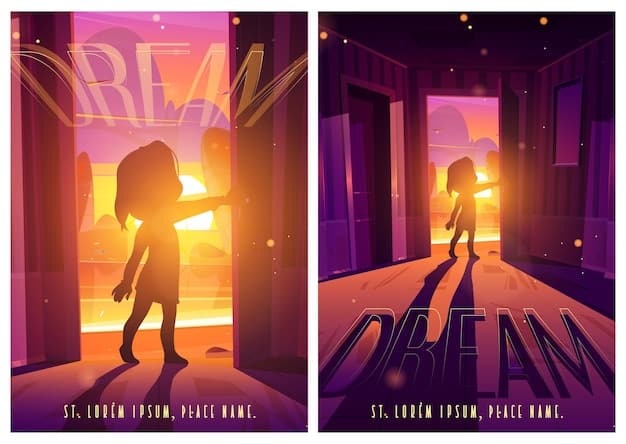Short Film Screenwriting Secrets: Compelling US Narratives in 15 Minutes

Short Film Screenwriting Secrets: Crafting Compelling Narratives in Under 15 Minutes for US Audiences involves mastering concise storytelling, focusing on character development, and understanding the nuances of pacing to captivate viewers within a limited timeframe.
Want to learn the Short Film Screenwriting Secrets: Crafting Compelling Narratives in Under 15 Minutes for US Audiences? Short films offer a unique platform for storytelling, demanding precision and impact. Let’s explore how to make every second count, tailored for US audiences.
Mastering the Art of Concise Storytelling
Crafting a compelling short film narrative requires a different approach than feature-length screenplays. The key lies in mastering the art of concise storytelling, where every scene and dialogue serves a purpose.
In the realm of short films, brevity is not a limitation but a strength. It forces the screenwriter to distill the essence of the story, focusing on the most crucial elements that resonate with the audience.
The Importance of a Strong Hook
The opening moments of a short film are critical for grabbing the viewer’s attention. A strong hook can be a visual, a line of dialogue, or an intriguing situation that immediately immerses the audience in the story.
Eliminating Unnecessary Elements
One of the biggest challenges in short film writing is cutting out anything that doesn’t directly contribute to the narrative. This includes subplots, secondary characters, and overly descriptive scenes.
- Prioritize the core conflict and theme.
- Streamline dialogue to convey only essential information.
- Use visuals to tell the story whenever possible.
- Ensure every scene propels the narrative forward.

By focusing on the essentials, screenwriters can create a powerful and memorable impact, leaving a lasting impression on the viewers.
Developing Compelling Characters Quickly
In a short film, you don’t have the luxury of gradually unfolding a character’s personality and motivations. You need to establish them quickly and effectively.
Developing compelling characters that resonate with the audience is crucial for a short film’s success. Even with limited screen time, characters should be relatable, engaging viewers emotionally.
Establishing Key Traits and Motivations
Focus first on key personality traits, making them immediately apparent through dialogue, action, and visual cues. Show don’t tell – let the audience infer character traits from their behavior.
Creating Relatable Characters
Root your character in a universal emotion or experience, making them relatable to people regardless of their background. This could include conflict, desire, ambition, or love.
- Define a clear goal or desire for the main character.
- Use costumes and props to reveal character traits.
- Write engaging dialogue that reveals personality.
- Create a compelling backstory hinted at throughout the film.
Investing time in developing compelling characters will make your story more engaging and memorable, allowing the audience to emotionally connect with your film.
Structure: Adapting the Three-Act for Brevity
Traditional three-act structure can be adapted to fit the constraints of a short film while maintaining a compelling narrative flow. Understand the key elements:
Adapting the three-act structure for short films involves compressing the traditional framework into a more concise format, ensuring all essential elements are present: exposition, rising action, climax, falling action, and resolution.
Act One: The Setup
This section introduces the main character, setting, and inciting incident. It sets the stage for the conflict the character will face, establishes the mood and tone of the film, and hooks the audience quickly.
Act Two: Confrontation
Here, the main character takes action, facing conflicts that escalate the stakes. This act builds tension and suspense, keeping the audience engaged. It includes surprises, setbacks, and challenges.

Act Three: Resolution
The climax occurs, followed by the falling action and resolution. The main character confronts the primary conflict, leading to either success or failure. The act provides a satisfying and emotional conclusion.
- Use visuals to condense exposition.
- Focus on a single, central conflict.
- Create a strong, impactful resolution.
- Think about the overall emotional journey.
By understanding and adapting the three-act structure, screenwriters can create well-paced and impactful narratives that resonate with viewers, even in a short format.
Pacing: Keeping the Audience Engaged
Pacing is essential in short films. A well-paced film keeps the audience engaged, creating interest in the story’s events, mood, and characters.
Mastering pacing ensures your story unfolds in a way that maximizes audience engagement. Fast pacing can create excitement, while slower pacing can build tension or reveal deeper emotions.
Creating a Sense of Urgency
Whether through tight deadlines or escalating stakes, give the audience a reason to care about what happens next. Use dialogue and action to convey the urgency.
Varying the Rhythm
Mix fast-paced scenes with slower, more reflective moments to create a dynamic viewing experience. Avoid monotony by varying the rhythm of scenes.
A well-paced short film captivates and enthralls the audience. By understanding and employing these pacing techniques, screenwriters can master the art of creating a truly memorable viewing experience.
Writing for US Audiences: Cultural Nuances and Expectations
Understanding the cultural preferences and expectations of your target audience is crucial. For US audiences, this means considering factors such as humor, value, and storytelling traditions.
Crafting a narrative that resonates with US audiences requires attention to cultural nuances, comedic timing, and thematic elements that appeal to their sensibilities. Authenticity and relatability are key.
Humor and Tone
US audiences often respond well to a mix of humor and heart. Use humor to lighten tense moments or create relatable characters, but make sure it aligns with the overall tone of your film.
Values and Themes
Explore themes that resonate with American values, such as freedom, justice, and the pursuit of happiness. Subtly weave these values into your story to create a more meaningful connection with the audience.
- Research current trends and cultural references in the US.
- Consider the demographics of your target audience.
- Watch a variety of American short films for inspiration.
- Seek feedback from US viewers during the development process.
Screenwriters can create short films that resonate deeply with US audiences, ensuring that their message is not only understood but also appreciated.
Revising and Editing: Polishing to Perfection
Once you’ve written your initial draft, the real work begins. Revising and editing are essential steps in crafting a polished and professional screenplay.
Revising involves restructuring scenes, refining character arcs, and tightening the plot. Editing is focused on correcting grammar, improving dialogue, and clarifying moments. Together, they ensure your script is the best it can be.
Seeking Feedback
Share your script with trusted colleagues, mentors, or friends and ask for honest feedback. Be open to criticism and use it to improve your work.
Cutting Unnecessary Scenes
Be ruthless in cutting any scenes or dialogue that don’t directly advance the plot or develop characters. Every second counts in a short film, so make sure every scene is essential.
- Read the screenplay aloud to catch any awkward phrasing.
- Focus on dialogue that reveals character.
- Look for opportunities to show, not tell.
- Ensure the ending is satisfying and memorable.
Following these revision and editing tips will help you transform your screenplay into a polished masterpiece, ready to captivate audiences and leave a lasting impact.
| Key Point | Brief Description |
|---|---|
| 💡 Concise Storytelling | Every scene and line must serve a purpose. |
| 🎬 Compelling Characters | Give viewers relatable and engaging personalities, even briefly. |
| ⏱️ Master Pacing | Keeping the audience engaged with the story’s events. |
| 🇺🇸 Audience Nuances | Adapting storytelling for the US audience. |
FAQ
▼
Aim for 10-15 pages. This usually translates to a film that is around 10-15 minutes long. Keep it concise and focus on the core story.
▼
Focus on a unique concept, well-developed characters, and a compelling narrative. Technical excellence can elevate the film as well.
▼
Avoid unnecessary subplots, too many characters, and poorly defined conflicts. Ensure pacing keeps the audience engaged to the end.
▼
The ending is crucial. Make it impactful, memorable, and satisfying. It should resonate with the audience and leave a lasting impression.
▼
Share your script with trusted friends, colleagues, or online screenwriting communities. Consider hiring a professional script consultant for detailed feedback.
Conclusion
Mastering the Short Film Screenwriting Secrets: Crafting Compelling Narratives in Under 15 Minutes for US Audiences involves a blend of concise storytelling, compelling characters, and an understanding of cultural nuances. By focusing on what truly matters, screenwriters can create engaging films that leave a lasting impact on US audiences.





